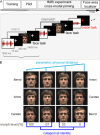How the human brain exchanges information across sensory modalities to recognize other people
- PMID: 25220190
- PMCID: PMC6869110
- DOI: 10.1002/hbm.22631
How the human brain exchanges information across sensory modalities to recognize other people
Abstract
Recognizing the identity of other individuals across different sensory modalities is critical for successful social interaction. In the human brain, face- and voice-sensitive areas are separate, but structurally connected. What kind of information is exchanged between these specialized areas during cross-modal recognition of other individuals is currently unclear. For faces, specific areas are sensitive to identity and to physical properties. It is an open question whether voices activate representations of face identity or physical facial properties in these areas. To address this question, we used functional magnetic resonance imaging in humans and a voice-face priming design. In this design, familiar voices were followed by morphed faces that matched or mismatched with respect to identity or physical properties. The results showed that responses in face-sensitive regions were modulated when face identity or physical properties did not match to the preceding voice. The strength of this mismatch signal depended on the level of certainty the participant had about the voice identity. This suggests that both identity and physical property information was provided by the voice to face areas. The activity and connectivity profiles differed between face-sensitive areas: (i) the occipital face area seemed to receive information about both physical properties and identity, (ii) the fusiform face area seemed to receive identity, and (iii) the anterior temporal lobe seemed to receive predominantly identity information from the voice. We interpret these results within a prediction coding scheme in which both identity and physical property information is used across sensory modalities to recognize individuals.
Keywords: cross-modal priming; face recognition; multisensory; person identity; voice recognition.
© 2014 Wiley Periodicals, Inc.
Figures




Similar articles
-
Activation in the angular gyrus and in the pSTS is modulated by face primes during voice recognition.Hum Brain Mapp. 2017 May;38(5):2553-2565. doi: 10.1002/hbm.23540. Epub 2017 Feb 20. Hum Brain Mapp. 2017. PMID: 28218433 Free PMC article.
-
Interaction of face and voice areas during speaker recognition.J Cogn Neurosci. 2005 Mar;17(3):367-76. doi: 10.1162/0898929053279577. J Cogn Neurosci. 2005. PMID: 15813998
-
Faces and voices in the brain: A modality-general person-identity representation in superior temporal sulcus.Neuroimage. 2019 Nov 1;201:116004. doi: 10.1016/j.neuroimage.2019.07.017. Epub 2019 Jul 9. Neuroimage. 2019. PMID: 31299368
-
A unified coding strategy for processing faces and voices.Trends Cogn Sci. 2013 Jun;17(6):263-71. doi: 10.1016/j.tics.2013.04.004. Epub 2013 May 10. Trends Cogn Sci. 2013. PMID: 23664703 Free PMC article. Review.
-
What the study of voice recognition in normal subjects and brain-damaged patients tells us about models of familiar people recognition.Neuropsychologia. 2011 Jul;49(9):2273-82. doi: 10.1016/j.neuropsychologia.2011.04.027. Epub 2011 May 4. Neuropsychologia. 2011. PMID: 21569784 Review.
Cited by
-
Dynamic neural architecture for social knowledge retrieval.Proc Natl Acad Sci U S A. 2017 Apr 18;114(16):E3305-E3314. doi: 10.1073/pnas.1621234114. Epub 2017 Mar 13. Proc Natl Acad Sci U S A. 2017. PMID: 28289200 Free PMC article.
-
Voice over: Audio-visual congruency and content recall in the gallery setting.PLoS One. 2017 Jun 21;12(6):e0177622. doi: 10.1371/journal.pone.0177622. eCollection 2017. PLoS One. 2017. PMID: 28636667 Free PMC article.
-
Familiarity Is Key: Exploring the Effect of Familiarity on the Face-Voice Correlation.Brain Sci. 2024 Jan 23;14(2):112. doi: 10.3390/brainsci14020112. Brain Sci. 2024. PMID: 38391687 Free PMC article.
-
Apperceptive and Associative Forms of Phonagnosia.Curr Neurol Neurosci Rep. 2023 Jun;23(6):327-333. doi: 10.1007/s11910-023-01271-5. Epub 2023 May 3. Curr Neurol Neurosci Rep. 2023. PMID: 37133717 Free PMC article. Review.
-
The impact of low vision on social function: The potential importance of lost visual social cues.J Optom. 2023 Jan-Mar;16(1):3-11. doi: 10.1016/j.optom.2022.03.003. Epub 2022 May 12. J Optom. 2023. PMID: 35568628 Free PMC article. Review.
References
-
- Adachi I, Kuwahata H, Fujita K (2007): Dogs recall their owner's face upon hearing the owner's voice. Anim Cogn 10:17–21. - PubMed
-
- Andics A, McQueen JM, Petersson KM, Gal V, Rudas G, Vidnyanszky Z (2010): Neural mechanisms for voice recognition. Neuroimage 52:1528–1540. - PubMed
-
- Anzellotti S, Fairhall SL, Caramazza A (2014): Decoding representations of face identity that are tolerant to rotation. Cereb Cortex 24:1988–1995. - PubMed
Publication types
MeSH terms
Substances
LinkOut - more resources
Full Text Sources
Other Literature Sources

